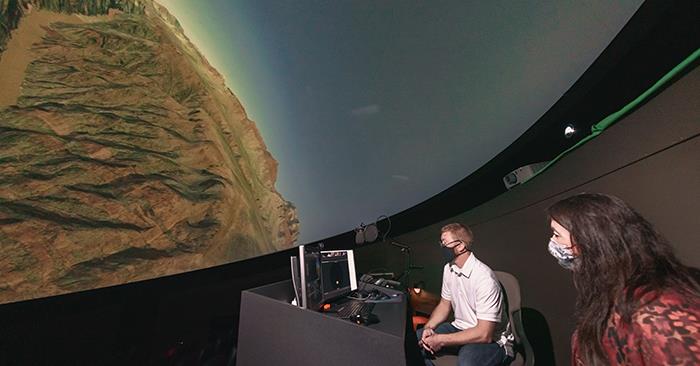To Infinity and Beyond: Planetarium Programming Fits Many Needs

Jared Young and Stephanie Russell project images for a show on the dome of the planetarium. The pair worked together to create a custom show for Russell’s class highlighting the impacts of climate change, urban sprawl and other man-made and natural geographic features of Earth.
While planetariums are typically associated with the heavens, programming can be adapted to fit a variety of needs. Truman’s planetarium has featured the seven wonders of the world, laser shows set to popular music, poetry readings and theatre events, to name just a few.
“What the planetarium can provide goes beyond general space exploration. The planetarium serves as a hub for liberal arts education,” said Jared Young, planetarium director. “Any department on campus can utilize the planetarium, and with the assistance of our staff, can build custom content to fit curricular needs. We’ve had professors build content for their courses, and students build content for class assignments.”
Young has helped coordinate original programming to fulfill multiple requests. Recently, he and Stephanie Russell, a visiting professor of history, were invited to participate in the Digistar Usergroup Conference and present on the custom-built geography show created for Russell’s class last year. Digistar is the software used in the Robison Planetarium, along with more than 2,000 other venues in more than 50 countries.
“Developing the show was such a rewarding, collaborative process,” Russell said. “Jared and I both were sort of figuring out what could be done. I had no idea what we could make, and, apparently, we’re doing something new with this software. That feels really good.”
Using new software installed in September 2019, Young worked weekly with Russell to create a show highlighting the impacts of climate change, urban sprawl and other man-made and natural geographic features of Earth.
“When I contacted Digistar with a formatting question regarding show production, we were encouraged to present the show at the conference, as it is a unique use of the software,” Young said.
Russell was not looking to be part of a groundbreaking use for the planetarium, but rather a way to help drive home course material to her students.
“The planetarium makes an impression,” she said. “It’s one thing to point at a flat map in the book and talk about the magnitude of the Amazon River. It’s another thing, entirely, to see the scale of the water flowing into the Atlantic, and how small other rivers are in comparison. I can show a picture of an atoll, but zooming through the sky into the vastness of the Pacific to a tiny coral reef really illustrates just how precarious the position of civilization can be in many places.”
In addition to specialized content for courses, Young and his staff have worked to create original programming for public shows. Mythology Monday, Final Frontier Friday and Stellar Saturday are all programs created in-house.
Mythology Monday is the brainchild of Alexandra Miller, a senior history major. She builds the shows herself, doing the research and determining what visuals to include. Rachel Thompson, a senior communication major, assists Miller in planetarium operation during shows.
Young serves as the host for Final Frontier Friday. He builds a new show each week that discusses various topics related to space exploration and discovery, such as exoplanets, star life cycles, the potential of life beyond Earth and the future of space exploration.
Stellar Saturday shows are completely operated by planetarium student-staff. Samantha Demoor and Samuel Thomas are the usual hosts. They research different space-themed topics ahead of time to present to audiences.
All planetarium shows encourage audience participation, which includes asking questions and suggesting places to travel.
In a normal year, the planetarium hosts 200 hours of programming, and at least that many shows. This includes public shows, field trips, guest lectures, movie nights and events hosted by student groups for area K-12 students, such as the Language Festival and the DARTS STEAM Summit. Annually, the planetarium consistently welcomes 4,500-5,000 visitors, including 25-30 field trips per year for K-12 students from northeast Missouri. The planetarium is available for reservation by organizations and off-campus entities.
For more information about the Del and Norma Robison Planetarium, visit planetarium.truman.edu.

